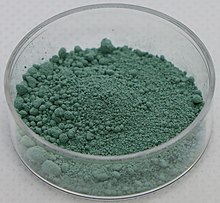
| |

| |
| Names | |
|---|---|
| IUPAC names
Uranium(IV) fluoride Uranium tetrafluoride | |
| Identifiers | |
| CAS Number | |
| 3D model (JSmol) | |
| ChemSpider | |
| ECHA InfoCard | 100.030.142 |
| EC Number |
|
| PubChem CID | |
| UNII | |
| CompTox Dashboard (EPA) | |
InChI
| |
SMILES
| |
| Properties | |
| Chemical formula | UF4 |
| Molar mass | 314.02 g/mol |
| Appearance | Green crystalline solid |
| Density | 6.70 g/cm, solid |
| Melting point | 1,036 °C (1,897 °F; 1,309 K) |
| Boiling point | 1,417 °C (2,583 °F; 1,690 K) |
| Solubility in water | Insoluble |
| Structure | |
| Crystal structure | Monoclinic, mS60 |
| Space group | C2/c, No. 15 |
| Hazards | |
| GHS labelling: | |
| Pictograms |   
|
| Signal word | Danger |
| Hazard statements | H300, H330, H373, H411 |
| Flash point | Non-flammable |
| Safety data sheet (SDS) | External MSDS |
| Related compounds | |
| Other anions | Uranium(IV) chloride Uranium(IV) bromide Uranium(IV) iodide Uranium dioxide |
| Other cations | Praseodymium(IV) fluoride Thorium(IV) fluoride Protactinium(IV) fluoride Neptunium(IV) fluoride Plutonium(IV) fluoride |
| Related compounds | Uranium hexafluoride |
| Except where otherwise noted, data are given for materials in their standard state (at 25 °C , 100 kPa).
| |
Uranium tetrafluoride is the inorganic compound with the formula UF4. It is a green solid with an insignificant vapor pressure and low solubility in water. Uranium in its tetravalent (uranous) state is important in various technological processes. In the uranium refining industry it is known as green salt.
Production
UF4 is prepared from UO2 in a fluidized bed by reaction with Hydrogen fluoride. The UO2 is derived from mining operations. Around 60,000 tonnes are prepared in this way annually. A common impurity is UO2F2. UF4 is susceptible to hydrolysis as well.
UF4 is formed by the reaction of UF6 with hydrogen gas in a vertical tube-type reactor. The bulk density of UF4 varies from about 2.0 g/cm to about 4.5 g/cm depending on the production process and the properties of the starting uranium compounds.
A molten salt reactor design, a type of nuclear reactor where the working fluid is a molten salt, would use UF4 as the core material. UF4 is generally chosen over related compounds because of the usefulness of the elements without isotope separation, better neutron economy and moderating efficiency, lower vapor pressure and better chemical stability.
Reactions
Uranium tetrafluoride reacts stepwise with fluorine, first to give uranium pentafluoride and then volatile UF6:
- 2 UF4 + F2 → 2 UF5
- 2 UF5 + F2 → 2 UF6
UF4 is reduced by magnesium to give the metal:
- UF4 + 2 Mg → U + 2 MgF2
UF4 reacts slowly with moisture at ambient temperature, forming UO2 and HF.
Structure
Like most binary metal fluorides, UF4 is a dense highly crosslinked inorganic polymer. As established by X-ray crystallography, the U centres are eight-coordinate with square antiprismatic coordination spheres. The fluoride centres are doubly bridging.
Safety
Like all uranium salts, UF4 is toxic and thus harmful by inhalation, ingestion, and through skin contact.
See also
- Praseodymium(IV) fluoride which has the same crystal structure
References of historical interest
- Booth, H. S.; Krasny-Ergen, W.; Heath, R. E. (1946). "Uranium Tetrafluoride". Journal of the American Chemical Society. 68 (10): 1969. doi:10.1021/ja01214a028.
References
- ^ Peehs, Martin; Walter, Thomas; Walter, Sabine; Zemek, Martin (2007). "Uranium, Uranium Alloys, and Uranium Compounds". Ullmann's Encyclopedia of Industrial Chemistry. Weinheim: Wiley-VCH. doi:10.1002/14356007.a27_281.pub2. ISBN 978-3527306732.
- ^ Greenwood, Norman N.; Earnshaw, Alan (1997). Chemistry of the Elements (2nd ed.). Butterworth-Heinemann. ISBN 978-0-08-037941-8.
- Kern, S.; Hayward, J.; Roberts, S.; Richardson, J. W.; Rotella, F. J.; Soderholm, L.; Cort, B.; Tinkle, M.; West, M.; Hoisington, D.; Lander, G. A. (1994). "Temperature Variation of the Structural Parameters in Actinide Tetrafluorides". The Journal of Chemical Physics. 101 (11): 9333–9337. Bibcode:1994JChPh.101.9333K. doi:10.1063/1.467963.
External links
- "Uranium Tetrafluoride". Appendix A of the PEIS (DOE/EIS-0269). Argonne National Laboratory. Archived from the original on 30 January 2016. Retrieved 22 November 2011.
| Uranium compounds | |||
|---|---|---|---|
| U(II) | |||
| U(III) |
| ||
| U(IV) |
| ||
| U(IV,V) | |||
| U(IV,VI) | |||
| U(V) | |||
| U(VI) | |||
| U(XII) |
| ||
| Halides of actinides | |||||||||||||||||||||||||||||||||||||||||||||||||||||||||||||||||||||||||||||||
|---|---|---|---|---|---|---|---|---|---|---|---|---|---|---|---|---|---|---|---|---|---|---|---|---|---|---|---|---|---|---|---|---|---|---|---|---|---|---|---|---|---|---|---|---|---|---|---|---|---|---|---|---|---|---|---|---|---|---|---|---|---|---|---|---|---|---|---|---|---|---|---|---|---|---|---|---|---|---|---|
| |||||||||||||||||||||||||||||||||||||||||||||||||||||||||||||||||||||||||||||||